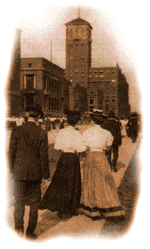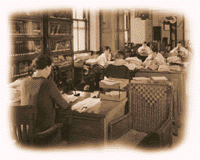|
Sears Settles in Chicago
Sears business expanded fast. So fast, in fact that the
company soon outgrew its rented five-story building. In
1896 Sears moved to a new six-story-and-basement building.
By the turn of the century, additional buildings were
built or leased in various areas of Chicago. Meanwhile,
construction was started on a 40-acre, $5 million
mail-order plant and office building on Chicago's West
Side. When opened in 1906, the mail-order plant, with more
than 3 million square feet of floor space, was the largest
business building in the world.
In 1906, Sears opened an office in Dallas, Texas, which
six years later blossomed into a mail-order plant. This
plant offered the Southwest such advantages as lower
freight rates, faster delivery and reduced damage to
merchandise. Sears wrote:
"If with this trial we can get any success, the
next place will get the kind of preparation that will
insure success, and encourage us to cover the United
States rapidly with 10 or more branches..."
Building mail-order plants was one thing. Making them
operate efficiently was something else. Around the turn of
the century a customer complained:
For heaven's sake, quit sending me sewing machines.
Every time I go to the station I find another one there.
You have shipped me five already.
 Sears
mail-order executives knew of these problems and were as
unhappy as the customers about them. After much
experimenting, they introduced a time schedule. Under it,
each order, as it arrived, was given a time to be shipped.
Then no matter what happened, the order had to be in the
appropriate bin in the merchandise-assembly room at the
assigned time. It traveled to the room by an intricate
system of belts and chutes. Sears
mail-order executives knew of these problems and were as
unhappy as the customers about them. After much
experimenting, they introduced a time schedule. Under it,
each order, as it arrived, was given a time to be shipped.
Then no matter what happened, the order had to be in the
appropriate bin in the merchandise-assembly room at the
assigned time. It traveled to the room by an intricate
system of belts and chutes.
The time-scheduling system brought order to mail order,
enabling the Chicago plant, according to one expert, to
handle 10 times the business it handled before the system
was introduced. Before long, the system became a sort of
"seventh wonder" of the business world. Henry
Ford is reported to have visited the Chicago plant to
study the assembly-line technique used in the system.
While some executives were perfecting the scheduling
system, others were involved with other projects. Fanciful
catalog writing started by Sears became far less fanciful.
What's more, buyers began looking beyond price tags to the
quality of the good they were buying. The change in the
catalog from the flamboyant to the factual appears to have
started by the turn of the century, although Richard
Sears' influence continued for some time after. One Sears
authority says the change to factual catalog writing came
out of day-to-day decisions. Hundreds of decisions about
copy on specific products added up to a factually written
catalog.
Not only did copy improve, but some products such as
patent medicines were dropped. The 1912 catalog devoted
one less page to patent medicines than the 1911 catalog.
The 1913 catalog came out solidly against home remedies
under the banner line "Why We Have Discontinued
Patent Medicines." The improvement in the quality of
Sears goods goes hand in hand with the story of Sears
laboratory. As early as 1905 the company began insisting
not only on accurate catalog descriptions but also on
quality merchandise.
 The
first laboratory opened in 1911 and, in time, became known
as the "watchdog of the catalog" suggesting
minimum standards for some products spot-testing
mail-order plant merchandise conducting scientific
comparisons between Sears and competitors' products. The
first laboratory opened in 1911 and, in time, became known
as the "watchdog of the catalog" suggesting
minimum standards for some products spot-testing
mail-order plant merchandise conducting scientific
comparisons between Sears and competitors' products.
The Sears catalog has had a varied and interesting
career. In the old days it sold "heavyweight, nice
soft-finish, black" wool cheviot coats for $4.98;
men's suits for $9.95. It sold a "Stradivarius model
violin" for $6.10 and an $8 brass banquet lamp for
$2.30. The catalog, on occasion, was given away free; on
other occasions it cost as much as 50 cents.
Famous in catalog history is the plan Richard Sears
used to put his wish books into the hands of thousands of
potential new customers. In 1905 Sears wrote to the
company's best customers in Iowa, asking each to
distribute 24 catalogs among friends and neighbors. These
customers sent Sears the names of people who received the
catalogs. When these people, in turn, sent in orders, the
original customers received premiums for their work: a
stove, a bicycle or a sewing machine. With success in
Iowa, the system was applied in other states.
|


 Sears
mail-order executives knew of these problems and were as
unhappy as the customers about them. After much
experimenting, they introduced a time schedule. Under it,
each order, as it arrived, was given a time to be shipped.
Then no matter what happened, the order had to be in the
appropriate bin in the merchandise-assembly room at the
assigned time. It traveled to the room by an intricate
system of belts and chutes.
Sears
mail-order executives knew of these problems and were as
unhappy as the customers about them. After much
experimenting, they introduced a time schedule. Under it,
each order, as it arrived, was given a time to be shipped.
Then no matter what happened, the order had to be in the
appropriate bin in the merchandise-assembly room at the
assigned time. It traveled to the room by an intricate
system of belts and chutes. The
first laboratory opened in 1911 and, in time, became known
as the "watchdog of the catalog" suggesting
minimum standards for some products spot-testing
mail-order plant merchandise conducting scientific
comparisons between Sears and competitors' products.
The
first laboratory opened in 1911 and, in time, became known
as the "watchdog of the catalog" suggesting
minimum standards for some products spot-testing
mail-order plant merchandise conducting scientific
comparisons between Sears and competitors' products.